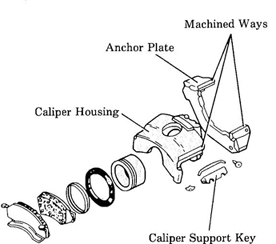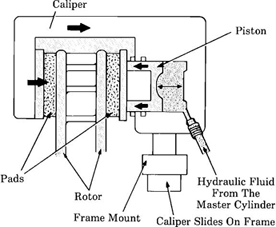Brake
Calipers
Any caliper that is leaking, has worn or damaged seals, or
is causing brake pads to wear unevenly, needs to be rebuilt
or replaced, but so do many calipers that appear to be
trouble-free.
After three or four years of service, most caliper bores and
steel pistons have visible corrosion and pitting. As the
surface of the piston becomes rough, it starts to wear the
piston seal. Every time the brakes are applied, the
roughness on the piston scrapes back and forth across the
seal. Eventually, the seal will fail and the caliper will
leak.
Although a caliper may not be leaking when the brakes are
relined, there is no guarantee how much longer the seals
will remain leak free. Seals and pads usually wear at the
same time, so it does not make much sense to fix one and not
the other.
It is extra expense and effort, but why should your customer
have to repeat a brake job in six months or a year when the
caliper he should have rebuilt or replaced starts to leak
and ruins the new pads you sold him?
In a sliding caliper, only one side of the caliper has an
apply piston. The caliper moves in relation to the rotor and
is held in a frame rigidly attached to the steering knuckle.
As linings wear, the piston gradually moves further out in
the caliper bore as the pads wear. When the piston is shoved
back in to accommodate new thicker pads, any dirt or
corrosion on the piston will be forced under the seal and
accelerate seal wear.
Another reason for rebuilding calipers is because rubber
piston seals deteriorate with age. A piston seal performs a
two-fold function; it seals the piston so hydraulic pressure
can apply the brakes, and it helps retract the piston when
the brakes are released.
As the piston is pushed out by the brake fluid, a square-cut
seal twists slightly. This helps pull the piston back when
the pressure is released, allowing pads to move away from
the rotor more easily for reduced brake drag and improved
pad wear and fuel economy.
Heat ages the seal. Over time, it loses elasticity and
becomes brittle. This reduces its ability to deform and pull
the piston back.
A neglected caliper can become a dragging caliper, causing
increased pad wear, fuel consumption, and possibly a
steering pull.
Rebuilding a caliper usually costs less than replacing it
with a remanufactured or new unit, but it does involve extra
time and effort.
Many professionals prefer the convenience of replacing old
calipers with rebuilt units rather than rebuilding the
calipers themselves. If a caliper can't be rebuilt because
of damage or severe wear, replacement is the only option.
OneStop Auto Shop
Call Today for
all of your Auto Repairs
and Maintenance
in Hollywood, Ca.!
(323) 227-9999
|

























